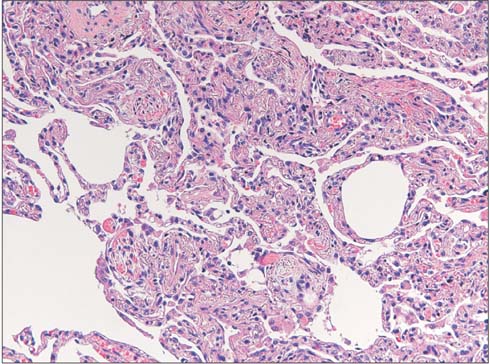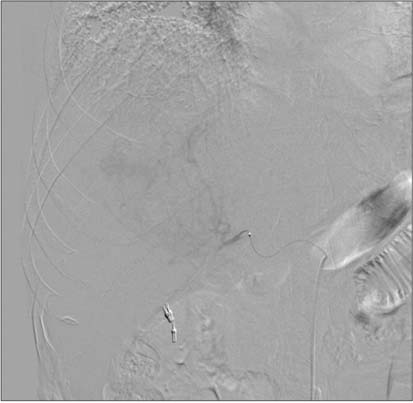Tuberc Respir Dis.
2015 Oct;78(4):469-472. 10.4046/trd.2015.78.4.469.
A Case of Cryptogenic Organizing Pneumonia after Transarterial Chemoembolization for the Treatment of Hepatocellular Carcinoma
- Affiliations
-
- 1Department of Internal Medicine, Konkuk University School of Medicine, Seoul, Korea. 20120082@kuh.ac.kr
- KMID: 2320730
- DOI: http://doi.org/10.4046/trd.2015.78.4.469
Abstract
- Cryptogenic organizing pneumonia (COP) is an inflammatory lung disease involving the distal bronchioles, respiratory bronchioles, bronchiolar ducts, and alveolae. The etiology is usually unknown; however, there are several known causes and associated systemic diseases. Corticosteroid therapy is the best treatment option and the prognosis of COP is good, with recovery in up to 80% of patients. We described a patient with in-operable hepatocellular carcinoma (HCC) undergoing chemoembolization with doxorubicin in a drug-eluting bead (DEB). COP developed in the patient after chemoembolization but resolved spontaneously in several months.
MeSH Terms
Figure
Reference
-
1. Cazzato S, Zompatori M, Baruzzi G, Schiattone ML, Burzi M, Rossi A, et al. Bronchiolitis obliterans-organizing pneumonia: an Italian experience. Respir Med. 2000; 94:702–708.2. Chang J, Han J, Kim DW, Lee I, Lee KY, Jung S, et al. Bronchiolitis obliterans organizing pneumonia: clinicopathologic review of a series of 45 Korean patients including rapidly progressive form. J Korean Med Sci. 2002; 17:179–186.3. Epler GR. Bronchiolitis obliterans organizing pneumonia, 25 years: a variety of causes, but what are the treatment options? Expert Rev Respir Med. 2011; 5:353–361.4. Aladdin M, Ilyas M. Chemoembolization of hepatocellular carcinoma with drug-eluting beads complicated by interstitial pneumonitis. Semin Intervent Radiol. 2011; 28:218–221.5. Sacco R, Bargellini I, Bertini M, Bozzi E, Romano A, Petruzzi P, et al. Conventional versus doxorubicin-eluting bead transarterial chemoembolization for hepatocellular carcinoma. J Vasc Interv Radiol. 2011; 22:1545–1552.6. Shin SW. The current practice of transarterial chemoembolization for the treatment of hepatocellular carcinoma. Korean J Radiol. 2009; 10:425–434.7. Xia J, Ren Z, Ye S, Sharma D, Lin Z, Gan Y, et al. Study of severe and rare complications of transarterial chemoembolization (TACE) for liver cancer. Eur J Radiol. 2006; 59:407–412.8. Ryu JH. Chemotherapy-induced pulmonary toxicity in lung cancer patients. J Thorac Oncol. 2010; 5:1313–1314.9. Jacobs C, Slade M, Lavery B. Doxorubicin and BOOP. A possible near fatal association. Clin Oncol (R Coll Radiol). 2002; 14:262.10. Stover DE, Milite F, Zakowski M. A newly recognized syndrome: radiation-related bronchiolitis obliterans and organizing pneumonia. A case report and literature review. Respiration. 2001; 68:540–544.11. Ogo E, Komaki R, Fujimoto K, Uchida M, Abe T, Nakamura K, et al. A survey of radiation-induced bronchiolitis obliterans organizing pneumonia syndrome after breast-conserving therapy in Japan. Int J Radiat Oncol Biol Phys. 2008; 71:123–131.
- Full Text Links
- Actions
-
Cited
- CITED
-
- Close
- Share
- Similar articles
-
- Efficacy of Hepatic Arterial Infusion Chemotherapy and Radiofrequency Ablation against Hepatocellular Carcinoma Refractory to Transarterial Chemoembolization and Vascular Variation: A Case Study
- Complications Related to Transarterial Treatment of Hepatocellular Carcinoma: A Comprehensive Review
- Transarterial Chemoembolization in Patients with Hepatocellular Carcinoma and Extrahepatic Metastasis
- Rare Case of Pyogenic Brain Abscess after Transarterial Chemoembolization in a Patient with Hepatocellular Carcinoma: Case Report and Literature Review
- The Role of Combination of Transarterial Chemoebolization and Radiofrequency Ablation for Hepatocellular Carcinoma Treatment





